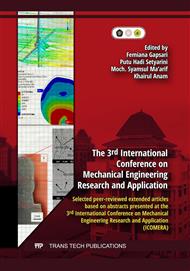[1]
C. Tarhan and M. A. Çil, "A study on hydrogen, the clean energy of the future: Hydrogen storage methods," J. Energy Storage, vol. 40, no. May, p.102676, 2021.
DOI: 10.1016/j.est.2021.102676
Google Scholar
[2]
L. S. Jensen, C. Kaul, N. B. Juncker, M. H. Thomsen, and T. Chaturvedi, "Biohydrogen Production in Microbial Electrolysis Cells Utilizing Organic Residue Feedstock: A Review," Energies, vol. 15, no. 22, 2022.
DOI: 10.3390/en15228396
Google Scholar
[3]
P. Liu et al., "ScienceDirect A superhydrophilic NiFe electrode for industrial alkaline water electrolysis," Int. J. Hydrogen Energy, no. xxxx, 2023.
DOI: 10.1016/j.ijhydene.2023.07.253
Google Scholar
[4]
A. M. Sulaiman, S. Mas'ud, A. N. Daroini, and P. Purnami, "the Effect of Electrode Coating From Bisphenol-a-Polycarbonate Cd-R Waste for Hydrogen Production," Int. J. Mech. Eng. Technol. Appl., vol. 4, no. 1, p.10–21, 2023.
DOI: 10.21776/mechta.2023.004.01.2
Google Scholar
[5]
S. Mas'ud, A. M. Sulaiman, H. Syahputra, and P. Purnami, "the Effect of Addition Bisphenol-a-Polycarbonate From Cd-R Waste As a Catalyst for Hydrogen Production," Int. J. Mech. Eng. Technol. Appl., vol. 4, no. 2, p.104–116, 2023.
DOI: 10.21776/mechta.2023.004.02.1
Google Scholar
[6]
X. Xu, Z. Shao, and S. P. Jiang, "High-Entropy Materials for Water Electrolysis," Energy Technol., vol. 10, no. 11, 2022.
DOI: 10.1002/ente.202200573
Google Scholar
[7]
M. Praveen Kumar et al., "NiFe Layered Double Hydroxide Electrocatalyst Prepared via an Electrochemical Deposition Method for the Oxygen Evolution Reaction," Catalysts, vol. 12, no. 11, 2022.
DOI: 10.3390/catal12111470
Google Scholar
[8]
J. Zhao, J. J. Zhang, Z. Y. Li, and X. H. Bu, "Recent Progress on NiFe-Based Electrocatalysts for the Oxygen Evolution Reaction," Small, vol. 16, no. 51, p.1–23, 2020.
DOI: 10.1002/smll.202003916
Google Scholar
[9]
P. Xiong et al., "Interface modulation of two-dimensional superlattices for efficient overall water splitting," Nano Lett., vol. 19, no. 7, p.4518–4526, 2019.
DOI: 10.1021/acs.nanolett.9b01329
Google Scholar
[10]
J. Mohammed-Ibrahim, "A review on NiFe-based electrocatalysts for efficient alkaline oxygen evolution reaction," J. Power Sources, vol. 448, no. September, p.227375, 2020.
DOI: 10.1016/j.jpowsour.2019.227375
Google Scholar
[11]
A. Kumar and S. Bhattacharyya, "Porous NiFe-Oxide Nanocubes as Bifunctional Electrocatalysts for Efficient Water-Splitting," ACS Appl. Mater. Interfaces, vol. 9, no. 48, p.41906–41915, 2017.
DOI: 10.1021/acsami.7b14096
Google Scholar
[12]
Z. Angeles-Olvera, A. Crespo-Yapur, O. Rodríguez, J. L. Cholula-Díaz, L. M. Martínez, and M. Videa, Nickel-Based Electrocatalysts for Water Electrolysis, vol. 15, no. 5. 2022.
DOI: 10.3390/en15051609
Google Scholar
[13]
V. Vij et al., "Nickel-based electrocatalysts for energy-related applications: Oxygen reduction, oxygen evolution, and hydrogen evolution reactions," ACS Catal., vol. 7, no. 10, p.7196–7225, 2017.
DOI: 10.1021/acscatal.7b01800
Google Scholar
[14]
M. Gong, D.Y. Wang, C.C. Chen, B.J. Hwang, and H. Dai, "A mini review on nickel-based electrocatalysts for alkaline hydrogen evolution reaction," Nano Res., vol. 9, no. 1, p.28–46, 2016.
DOI: 10.1007/s12274-015-0965-x
Google Scholar
[15]
M. Gong et al., "An advanced Ni-Fe layered double hydroxide electrocatalyst for water oxidation," J. Am. Chem. Soc., vol. 135, no. 23, p.8452–8455, 2013.
DOI: 10.1021/ja4027715
Google Scholar
[16]
F. Si et al., "NiFe-LDH nanosheets with high activity in three dimensions on NiFe foam electrode for water oxidation," Int. J. Hydrogen Energy, no. xxxx, 2023.
DOI: 10.1016/j.ijhydene.2023.07.024
Google Scholar
[17]
O. Diaz-Morales, I. Ledezma-Yanez, M. T. M. Koper, and F. Calle-Vallejo, "Guidelines for the Rational Design of Ni-Based Double Hydroxide Electrocatalysts for the Oxygen Evolution Reaction," ACS Catal., vol. 5, no. 9, p.5380–5387, 2015.
DOI: 10.1021/acscatal.5b01638
Google Scholar
[18]
A. Sakamaki, M. Yoshida-Hirahara, H. Ogihara, and H. Kurokawa, "One-Step Synthesis of Highly Active NiFe Electrocatalysts for the Oxygen Evolution Reaction," Langmuir, 2022.
DOI: 10.1021/acs.langmuir.2c00097
Google Scholar
[19]
J.X. Yang et al., "Rapid Fabrication of High-Entropy Ceramic Nanomaterials for Catalytic Reactions," ACS Nano, vol. 15, no. 7, p.12324–12333, 2021.
DOI: 10.1021/acsnano.1c04259
Google Scholar
[20]
C.C.L. McCrory, S. Jung, J.C. Peters, and T.F. Jaramillo, "Benchmarking heterogeneous electrocatalysts for the oxygen evolution reaction," J. Am. Chem. Soc., vol. 135, no. 45, p.16977–16987, 2013.
DOI: 10.1021/ja407115p
Google Scholar
[21]
P. Connor, J. Schuch, B. Kaiser, and W. Jaegermann, "The Determination of Electrochemical Active Surface Area and Specific Capacity Revisited for the System MnOx as an Oxygen Evolution Catalyst," Zeitschrift fur Phys. Chemie, vol. 234, no. 5, p.979–994, 2020.
DOI: 10.1515/zpch-2019-1514
Google Scholar
[22]
M. S. Islam, J. Kurawaki, Y. Kusumoto, M. Abdulla-Al-Mamun, and M. Z. Bin Mukhlish, "Hydrothermal Novel Synthesis of Neck-structured Hyperthermia-suitable Magnetic (Fe3O4, γ-Fe2O3 and α-Fe2O3) Nanoparticles," J. Sci. Res., vol. 4, no. 1, p.99, 2011.
DOI: 10.3329/jsr.v4i1.8727
Google Scholar
[23]
L. Agusu, Alimin, L. O. Ahmad, M. Z. Firihu, S. Mitsudo, and H. Kikuchi, "Crystal and microstructure of MnFe2O4 synthesized by ceramic method using manganese ore and iron sand as raw materials," J. Phys. Conf. Ser., vol. 1153, no. 1, p.2–9, 2019.
DOI: 10.1088/1742-6596/1153/1/012056
Google Scholar
[24]
K. A. M. Ahmed, Q. Zeng, K. Wu, and K. Huang, "Mn3O4 nanoplates and nanoparticles: Synthesis, characterization, electrochemical and catalytic properties," J. Solid State Chem., vol. 183, no. 3, p.744–751, 2010.
DOI: 10.1016/j.jssc.2010.01.015
Google Scholar
[25]
L. Cai et al., "Active site engineering of Fe- and Ni-sites for highly efficient electrochemical overall water splitting," J. Mater. Chem. A, vol. 6, no. 43, p.21445–21451, 2018.
DOI: 10.1039/C8TA08217K
Google Scholar
[26]
L. Trotochaud, S. L. Young, J. K. Ranney, and S. W. Boettcher, "Nickel-Iron oxyhydroxide oxygen-evolution electrocatalysts: The role of intentional and incidental iron incorporation," J. Am. Chem. Soc., vol. 136, no. 18, p.6744–6753, 2014.
DOI: 10.1021/ja502379c
Google Scholar
[27]
M.M. Sk, C.Y. Yue, K. Ghosh, and R.K. Jena, "Review on advances in porous nanostructured nickel oxides and their composite electrodes for high-performance supercapacitors," J. Power Sources, vol. 308, p.121–140, 2016.
DOI: 10.1016/j.jpowsour.2016.01.056
Google Scholar
[28]
E. Cossar, M. S. E. Houache, Z. Zhang, and E. A. Baranova, "Comparison of electrochemical active surface area methods for various nickel nanostructures," J. Electroanal. Chem., vol. 870, p.114246, 2020.
DOI: 10.1016/j.jelechem.2020.114246
Google Scholar
[29]
B. A. Mei, O. Munteshari, J. Lau, B. Dunn, and L. Pilon, "Physical Interpretations of Nyquist Plots for EDLC Electrodes and Devices," J. Phys. Chem. C, vol. 122, no. 1, p.194–206, 2018.
DOI: 10.1021/acs.jpcc.7b10582
Google Scholar



